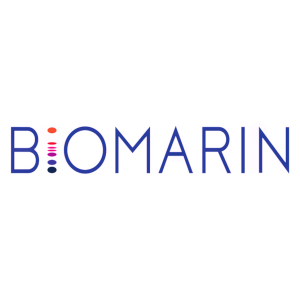FDA Accepts BioMarin's PALYNZIQ® (pegvaliase-pqpz) Supplemental Biologics License Application for Priority Review to Expand Use to Adolescents Aged 12-17 with Phenylketonuria
Rhea-AI Summary
BioMarin (Nasdaq: BMRN) announced the FDA has accepted for Priority Review its supplemental biologics license application to expand PALYNZIQ (pegvaliase-pqpz) for adolescents aged 12–17 with phenylketonuria (PKU).
The sBLA is based on positive Phase 3 PEGASUS results showing statistically significant reductions in blood phenylalanine (Phe) versus diet alone. The FDA set a PDUFA target action date of Feb. 28, 2026. Data were presented at the 15th ICIEM in Kyoto, and BioMarin plans to seek a similar label expansion with the European Medicines Agency. PALYNZIQ is currently the first and only enzyme substitution therapy approved for adults with PKU.
Positive
- FDA granted Priority Review for the adolescent sBLA
- PDUFA target action date set for Feb. 28, 2026
- Phase 3 PEGASUS showed statistically significant Phe lowering versus diet alone
- Company pursuing parallel regulatory engagement with European Medicines Agency
Negative
- Approval is not granted yet; final FDA decision pending Feb. 28, 2026
- PEGASUS was an open-label randomized controlled study, which can limit blinded outcome assessment
News Market Reaction 1 Alert
On the day this news was published, BMRN declined 3.05%, reflecting a moderate negative market reaction.
Data tracked by StockTitan Argus on the day of publication.
Application based on positive results from Phase 3 PEGASUS study, which demonstrated statistically significant blood phenylalanine (Phe) lowering compared to diet alone
FDA PDUFA target action date of Feb. 28, 2026
"Adolescents and young adults with PKU need better options that can deliver meaningful reductions in blood Phe levels and provide greater dietary freedom," said Greg Friberg, M.D., Executive Vice President and Chief Research & Development Officer at BioMarin. "The results we observed in the PEGASUS trial demonstrated the potential PALYNZIQ can offer to help adolescents achieve guideline-recommended and even normal Phe levels, while eating significantly more protein from whole foods. For more than two decades, BioMarin has led the way in driving scientific progress in partnership with the PKU community, and we look forward to working closely with the FDA with the goal of expanding treatment with PALYNZIQ to adolescents as soon as possible."
The company is also working to share these data with the European Medicines Agency with the goal of expanding treatment with PALYNZIQ to include adolescents as young as age 12 in the European Union.
The sBLA is based on data from PEGASUS, a Phase 3 multi-center open-label randomized controlled study evaluating the safety and efficacy of PALYNZIQ compared to diet alone in adolescents aged 12-17 with PKU. These data were recently presented at the 15th International Congress of Inborn Errors of Metabolism (ICIEM) in
PALYNZIQ is the first and only enzyme substitution therapy approved to treat adults with PKU.
About PEGASUS
PEGASUS is a Phase 3 multi-center open-label randomized controlled study evaluating the safety and efficacy of PALYNZIQ compared to diet alone in 55 adolescents aged 12-17 with phenylketonuria. The primary endpoints are change in blood Phe concentration and characterization of the safety profile in adolescents. Secondary endpoints include pharmacokinetics and change in total dietary protein intake.
The study is being conducted in two parts: the primary treatment phase ranging from weeks 1-73 (Part 1), and the extension phase (Part 2), which lasts for up to an additional 80 weeks of monitoring for the PALYNZIQ arm and allows for crossover for those in the diet-only arm.
For more information, please visit clinicaltrials.biomarin.com.
About PALYNZIQ
PALYNZIQ substitutes the deficient phenylalanine hydroxylase (PAH) enzyme in PKU with a PEGylated version of the enzyme phenylalanine ammonia lyase to break down Phe. PALYNZIQ is administered using a dosing regimen designed to facilitate tolerability; PALYNZIQ's safety profile consists primarily of immune-mediated responses, which can include anaphylaxis, for which robust risk management measures effective in clinical trials are in place.
PALYNZIQ is approved for the treatment of PKU in more than 35 countries worldwide.
Patient Support Accessing PALYNZIQ
To reach a BioMarin RareConnections® Case Manager, please call, toll-free, 1-866-906-6100 or e-mail support@biomarin-rareconnections.com. For more information about PALYNZIQ, please visit www.palynziq.com. For additional information regarding this product, please contact BioMarin Medical Information at medinfo@bmrn.com.
About Phenylketonuria
PKU, or phenylalanine hydroxylase (PAH) deficiency, is a genetic condition affecting approximately 70,000 people in the regions of the world where BioMarin operates. The PAH enzyme is required for the metabolism of Phe, an essential amino acid found in most protein-containing foods. If functional enzyme is not present in sufficient quantities, Phe accumulates to abnormally high levels in the blood and becomes toxic to the brain, resulting in a variety of complications including severe intellectual disability, seizures, tremors, behavioral problems and psychiatric symptoms.
As a result of newborn screening efforts implemented in the 1960s and early 1970s, virtually all individuals with PKU born after this period in countries with newborn screening programs are diagnosed at birth and treatment is implemented soon after.
PKU can be managed with a severe Phe-restricted diet, supplemented by low-protein modified foods and Phe-free medical foods; however, it is difficult for most individuals to adhere to this strict diet to the extent needed to achieve adequate control of blood Phe levels. Dietary control of Phe in childhood can prevent major developmental issues and neurological consequences, but poor Phe control in adolescence and adulthood is associated with a range of neuropsychological deficits and functional impairment.
PALYNZIQ
PALYNZIQ® (pegvaliase-pqpz) is a phenylalanine (Phe)-metabolizing enzyme indicated to reduce blood Phe levels in adult patients with phenylketonuria who have uncontrolled blood Phe levels greater than 600 micromol/L on existing management.
BOXED WARNING: RISK OF ANAPHYLAXIS
- Anaphylaxis has been reported after administration of PALYNZIQ and may occur at any time during treatment
- Administer the initial dose of PALYNZIQ under the supervision of a healthcare provider equipped to manage anaphylaxis, and closely observe patients for at least 60 minutes following injection. Prior to self-injection, confirm patient competency with self-administration, and patient's and observer's (if applicable) ability to recognize signs and symptoms of anaphylaxis and to administer auto-injectable epinephrine, if needed
- Consider having an adult observer for patients who may need assistance in recognizing and managing anaphylaxis during PALYNZIQ treatment. If an adult observer is needed, the observer should be present during and for at least 60 minutes after PALYNZIQ administration, should be able to administer auto-injectable epinephrine, and call for emergency medical support upon its use
- Prescribe auto-injectable epinephrine. Prior to the first dose, instruct the patient and observer (if applicable) on its appropriate use. Instruct the patient to seek immediate medical care upon its use. Instruct patients to carry auto-injectable epinephrine with them at all times during PALYNZIQ treatment
- PALYNZIQ is available only through a restricted program called PALYNZIQ REMS (Risk Evaluation and Mitigation Strategy). Further information, including a list of qualified pharmacies, is available at www.PALYNZIQREMS.com or by telephone at 1-855-758-REMS (1-855-758-7367)
WARNINGS AND PRECAUTIONS
Anaphylaxis
- Signs and symptoms of anaphylaxis reported include syncope, hypotension, hypoxia, dyspnea, wheezing, chest discomfort/chest tightness, tachycardia, angioedema (swelling of face, lips, eyes, tongue), throat tightness, skin flushing, rash, urticaria, pruritus, and gastrointestinal symptoms (vomiting, nausea, diarrhea)
- Anaphylaxis generally occurred within 1 hour after injection; however, delayed episodes occurred up to 48 hours after PALYNZIQ administration
- Consider having an adult observer for patients who may need assistance in recognizing and managing anaphylaxis during PALYNZIQ treatment. If an adult observer is needed, the observer should be present during and for at least 60 minutes after PALYNZIQ administration, should be able to administer auto-injectable epinephrine, and call for emergency medical support upon its use
- Anaphylaxis requires immediate treatment with auto-injectable epinephrine. Prescribe auto-injectable epinephrine to all patients receiving PALYNZIQ and instruct patients to carry auto-injectable epinephrine with them at all times during PALYNZIQ treatment. Prior to the first dose, instruct the patient and observer (if applicable) on how to recognize the signs and symptoms of anaphylaxis, how to properly administer auto-injectable epinephrine, and to seek immediate medical care upon its use. Consider the risks associated with auto-injectable epinephrine use when prescribing PALYNZIQ. Refer to the auto-injectable epinephrine prescribing information for complete information
- Consider the risks and benefits of readministering PALYNZIQ following an episode of anaphylaxis. If the decision is made to readminister PALYNZIQ, administer the first dose under the supervision of a healthcare provider equipped to manage anaphylaxis and closely observe the patient for at least 60 minutes following the dose. Subsequent PALYNZIQ dose titration should be based on patient tolerability and therapeutic response
- Consider premedication with an H1-receptor antagonist, H2-receptor antagonist, and/or antipyretic prior to PALYNZIQ administration based upon individual patient tolerability
Other Hypersensitivity Reactions
- Hypersensitivity reactions other than anaphylaxis have been reported in 204 of 285 (
72% ) patients treated with PALYNZIQ in clinical trials - Management of hypersensitivity reactions should be based on the severity of the reaction, recurrence of the reaction, and the clinical judgment of the healthcare provider, and may include dosage adjustment, temporary drug interruption, or treatment with antihistamines, antipyretics, and/or corticosteroids
Injection Site Infections
- Serious injection site infections including abscess, cellulitis, necrosis, and ulcer have been reported. Some cases required hospitalization, surgical debridement, intravenous antibiotics, and discontinuation of PALYNZIQ
- Provide proper training to patients and/or caregivers on the use of aseptic injection technique. Advise patients to rotate injection sites with each dose and to check the site for redness, swelling, or tenderness. Instruct patients to contact their healthcare provider if signs or symptoms of an infection develop, persist, or worsen. Advise patients not to administer PALYNZIQ into the affected area until the infection has resolved
ADVERSE REACTIONS
- The most common adverse reactions (at least
20% of patients in either treatment phase) were injection site reactions, arthralgia, hypersensitivity reactions, headache, generalized skin reactions lasting at least 14 days, nausea, abdominal pain, vomiting, cough, oropharyngeal pain, pruritus, diarrhea, nasal congestion, fatigue, dizziness, and anxiety - Of the 285 patients exposed to PALYNZIQ in an induction/titration/maintenance regimen in clinical trials, 44 (
15% ) patients discontinued treatment due to adverse reactions. The most common adverse reactions leading to treatment discontinuation were hypersensitivity reactions (6% of patients) including anaphylaxis (3% of patients), angioedema (1% of patients), arthralgia (4% of patients), generalized skin reactions lasting at least 14 days (2% of patients), and injection site reactions (1% of patients) - The most common adverse reactions leading to dosage reduction were arthralgia (
15% of patients), hypersensitivity reactions (9% of patients), injection site reactions (4% of patients), alopecia (3% of patients), and generalized skin reactions lasting at least 14 days (2% of patients) - The most common adverse reactions leading to temporary drug interruption were hypersensitivity reactions (
14% of patients), arthralgia (13% of patients), anaphylaxis (4% of patients), and injection site reactions (4% of patients) - Angioedema and serum sickness: In clinical trials, 22 out of 285 (
8% ) patients experienced 45 episodes of angioedema (symptoms included: pharyngeal edema, swollen tongue, lip swelling, mouth swelling, eyelid edema, and face edema) occurring independent of anaphylaxis. In clinical trials, serum sickness was reported in 7 out of 285 (2% ) patients
Blood Phenylalanine Monitoring and Diet
- Obtain blood Phe concentrations every 4 weeks until a maintenance dosage is established. Periodically monitor blood Phe concentrations during maintenance therapy
- Counsel patients to monitor dietary protein and Phe intake, and adjust as directed by their healthcare provider
DRUG INTERACTIONS
Effect of PALYNZIQ on Other PEGylated Products
- In a single-dose study of PALYNZIQ in adult patients with PKU, two patients receiving concomitant injections of medroxyprogesterone acetate suspension (a formulation containing PEG 3350) experienced a hypersensitivity reaction. One of the two patients experienced anaphylaxis
- The clinical effects of concomitant treatment with different PEGylated products are unknown. Monitor patients treated with PALYNZIQ and concomitantly with other PEGylated products for hypersensitivity reactions including anaphylaxis
USE IN SPECIFIC POPULATIONS
Pregnancy and Lactation
- PALYNZIQ may cause fetal harm when administered to a pregnant woman
- Advise women who are exposed to PALYNZIQ during pregnancy or who become pregnant within one month following the last dose of PALYNZIQ that there is a pregnancy surveillance program that monitors pregnancy outcomes. Healthcare providers should report PALYNZIQ exposure and encourage these patients to report their pregnancy to BioMarin (1-866-906-6100)
- Monitor blood Phe levels in breastfeeding women treated with PALYNZIQ
Pediatric Use
- The safety and effectiveness of PALYNZIQ in pediatric patients have not been established
Geriatric Use
- Clinical studies of PALYNZIQ did not include patients aged 65 years and older
You are encouraged to report suspected adverse reactions to BioMarin at 1-866-906-6100, or to FDA at 1-800-FDA-1088 or www.fda.gov/medwatch.
Please see accompanying full Prescribing Information, including Boxed Warning.
About BioMarin
BioMarin is a leading, global rare disease biotechnology company focused on delivering medicines for people living with genetically defined conditions. Founded in 1997, the San Rafael,
Forward-Looking Statements
This press release contains forward-looking statements about the business prospects of BioMarin Pharmaceutical Inc. (BioMarin), including without limitation, statements about: BioMarin's expectations regarding its submission of the PALYNZIQ (pegvaliase-pqpz) supplemental Biologics License Application (sBLA) to expand treatment to include adolescents aged 12-17 with phenylketonuria (PKU), including expectations regarding the Prescription Drug User Fee Act (PDUFA) target action date; the safety profile and potential benefits of PALYNZIQ for adolescents, including the potential PALYNZIQ can offer to help adolescents achieve guideline-recommended and even normal Phe levels while eating significantly more protein from whole foods; the development of BioMarin's PALYNZIQ program generally, including plans to share data with the European Medicines Agency with the goal of expanding treatment with PALYNZIQ to include adolescents as young as age 12 in the European Union; and the continued clinical development of PALYNZIQ, including BioMarin's plans to continue to evaluate long-term results of PALYNZIQ treatment for adolescents through the ongoing extension phase of the PEGASUS trial. These forward-looking statements are predictions and involve risks and uncertainties such that actual results may differ materially from these statements. These risks and uncertainties include, among others: results and timing of current and planned preclinical studies and clinical trials of PALYNZIQ; any potential adverse events observed in the continuing monitoring of the patients in the clinical trials; the content and timing of decisions by the
BioMarin®, BioMarin RareConnections® and PALYNZIQ® are registered trademarks of BioMarin Pharmaceutical Inc.
|
|
|
|
Contacts: |
|
|
Investors |
Media |
|
Traci McCarty |
Katherine Powell |
|
BioMarin Pharmaceutical Inc. |
BioMarin Pharmaceutical Inc. |
|
(415) 455-7558 |
(415) 827-2968 |
![]() View original content to download multimedia:https://www.prnewswire.com/news-releases/fda-accepts-biomarins-palynziq-pegvaliase-pqpz-supplemental-biologics-license-application-for-priority-review-to-expand-use-to-adolescents-aged-12-17-with-phenylketonuria-302597628.html
View original content to download multimedia:https://www.prnewswire.com/news-releases/fda-accepts-biomarins-palynziq-pegvaliase-pqpz-supplemental-biologics-license-application-for-priority-review-to-expand-use-to-adolescents-aged-12-17-with-phenylketonuria-302597628.html
SOURCE BioMarin Pharmaceutical Inc.










